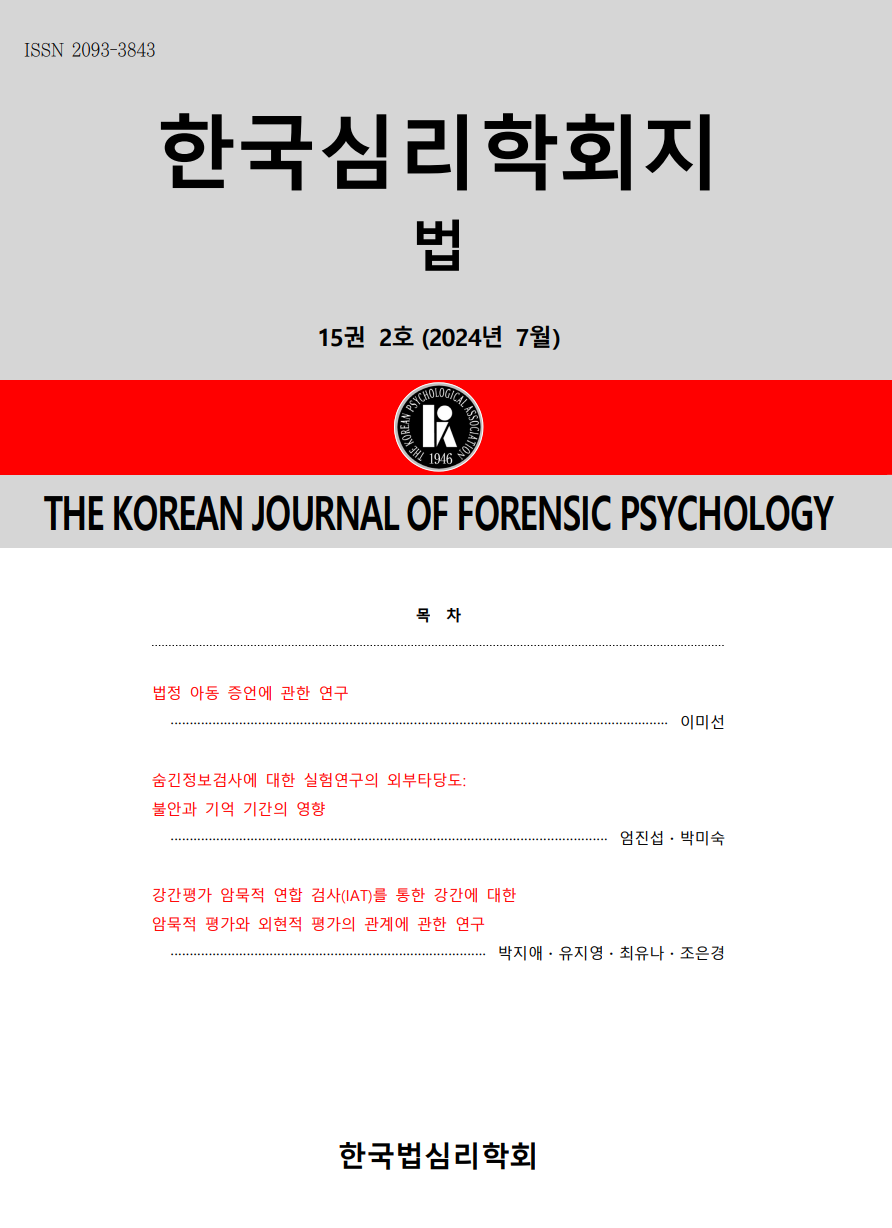open access
메뉴
open access
메뉴 ISSN : 2093-3843
ISSN : 2093-3843
Rape myth acceptance may influence victims are treated and perpetrator blamed and sentenced. And this relationship could be moderated by victim’s deviant behavior before rape such as teenage running away from home or drinking alcohol. The present study examined the relationship among rape myth, deviant behavior, blaming victim, pain of victim, responsibility and blame for perpetrator and punishment for the perpetrator. Findings suggest that participants with high rape myth acceptance compared to participants with low rape myth acceptance blamed victim more and blamed and thought responsible the perpetrator less. And this relationship was only significant when the victim had deviant behavior before rape happened. This result shows that specific information(deviant behaior) about victim could trigger rape myth to blame victim and judge the perpetrator leniently. The suggestions for future research and limitations were discussed.
김은지, 박지선. (2011). 성폭력 피해자와 가해자에 대한 일반인들의 태도. 한국심리학회지: 법정, 2(2), 171-183.
김보화, 허민숙, 김미순, & 장주리. (2018). 성폭력피해상담 분석 및 피해자 지원방안 연구 (보고서 번호: 11-1383000-000915-01). 여성가족부: 한국성폭력상담소.
문지영 (2020), ‘n번방’ 피해자들도 반성해야 한다는 ‘반일종족주의’ 저자 이우연(신문기사), https://www.ytn.co.kr/_ln/0103_202003251555064612
양동옥, 국혜윤, 백현경, 윤가현 (2012). 참가자의 성별, 피해여성의 옷차림 종류와 음주량 수준에 따른 성폭력 책임 귀인의 차이. 한국심리학회지: 여성, 17(3), 323-345.
윤병혜, 고재홍 (2006). 양가적 성차별 태도에 따른 성폭력 피해자에 대한 비난차이: 강간통념의 매개효과. 한국심리학회지: 여성, 11(1), 1-19.
이석재 (1999). 강간통념척도의 개발과 타당도 검증. 한국심리학회지: 사회 및 성격, 13(2), 131-148.
이석재, 최상진 (2001). 강간통념수용도에 따른 성행동, 성폭력 및 성폭행 사건지각. 한국심리학회지: 사회 및 성격, 15(1), 97-116.
이재영, & 유영재. (2018). 여성대상 범죄보도가 범죄와 형벌에 관한 인식에 미치는 영향. 한국범죄심리연구, 14, 103-118.
이재영. (2019). 언론보도에 나타난 여성 범죄피해자 비난에 대한 연구. 경찰학연구, 19(3), 153-184.
Anderson, C. A., & Anderson, K. B. (2008). Men who target women: Specificity of target, generality of aggressive behavior. Aggressive Behavior, 34, 605-622.
Beverly, A. K. (1996). Gender, gender identity myth acceptance, and time of initial resistance on the perception of acquaintance rape blame and avoidability. Sex Roles: A Journal of Research, 34, 81-93.
Blumberg, M. L., & Lester, D. (1991). High school and college students' attitudes toward rape. Adolescence, 26(103), 727.
Bowman, S. L. (2008). The female-to-male rape myths scale: initial scale development(Doctoral dissertation). Ball State University.
Brownmiller, S. (1975). Against our will: Men, women and rape. New York: Simon & Schuster.
Burt, M. R. (1980). Cultural myths and supports for rape. Journal of personality and social psychology, 38(2), 217.
Eagly, A. H., & Chaiken, S. (2007). The advantages of an inclusive definition of attitude. Social Cognition, 25, 582-602.
Fazio, R. H. (2007). Attitudes as object-evaluation associations of varying strength. Social Cognition, 25, 603-637.
Flintort, R. (2010). Sexual assault. Violence goes to college: The authoritative guide to prevention and intervention (2nd ed). Springfield, IL: Charles C. Thomas Publisher, LTD.
Hayes, R. M., Lorenz, K., & Bell, K. A. (2013). Victim blaming others: Rape myth acceptance and the just world belief. Feminist Criminology, 8(3), 202-220.
Jenkins, M. J., & Dambrot, F. H. (1987). The attribution of date rape: Observer's attitudes and sexual experiences and the dating situation. Journal of Applied Social Psychology, 17(10), 875-895.
LaFree, G. D. (1980a). The effect of sexual stratification by race on official reactions to rape. American Sociological Review, 45, 842-854.
LaFree, G. D. (1980b). Variables affecting guilty pleas and convictions in rape cases: Toward a social theory of rape processing. Social Forces, 58, 833-850.
Larcombe, W. (2011). Falling rape conviction rates:(Some) feminist aims and measures for rape law. Feminist Legal Studies, 19(1), 27-45.
Linz, D. G., Donnerstein, E., & Penrod, S. (1988). Effects of long-term exposure to violent and sexually degrading depictions of women. Journal of personality and social psychology, 55(5), 758.
Linz, D., Donnerstein, E., & Adams, S. M. (1989). Physiological desensitization and judgments about female victims of violence. Human Communication Research, 15(4), 509-522.
Lonsway, K. A., & Fitzgerald, L. F. (1994). Rape myths: In review. Psychology of Women Quarterly, 18, 133-164.
Malamuth, N. M., & Check, J. V. (1985). The effects of aggressive pornography on beliefs in rape myths: Individual differences. Journal of Research in Personality, 19(3), 299-320.
Muehlenhard, C. L., & MacNaughton, J. S. (1988). Women's beliefs about women who “lead men on”. Journal of Social and Clinical Psychology, 7(1), 65-79.
Parrot, D. J., & Zeichner, A. (2003). Effects of hyper-masculinity on physical aggression against women. Psychology of Men & Masculinity, 4, 70-78.
Payne, D. L., Lonsway, K. A., & Fitzgerald, L. F. (1999). Rape myth acceptance: Exploration of its structure and its measurement using the Illinois Rape Myth Acceptance Scale. Journal of Research in Personality, 33(1), 27-68.
Quackenbush, R. L. (1989). A comparison of androgynous, masculine sex-typed, and undifferentiated males on dimensions of attitudes toward rape. Journal of Research in Personality, 23(3), 318-342.
Richardson, D., & Campbell, J. L. (1982). Alcohol and rape: The effect of alcohol on attributions of blame for rape. Personality and Social Psychology Bulletin, 8(3), 468-476.
Schwendinger, J. R., & Schwendinger, H. (1974). Rape myths: In legal, theoretical, and everyday practice. Crime and Social Justice, (1), 18-26.
Suarez, E., & Gadalla, T. M. (2010). Stop blaming the victim: A meta-analysis on rape myths. Journal of Interpersonal Violence, 25(11), 2010-2035.